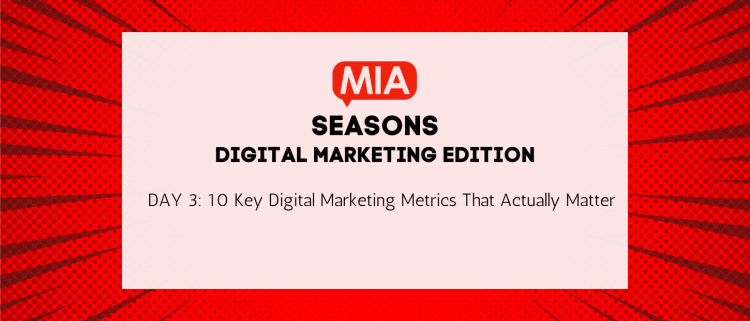Digital marketing metrics are important because they provide a window into the health and success of a company’s digital marketing strategy.
Many companies fail to see how their digital marketing strategy is doing because they focus on metrics that don’t measure success. If you want to improve your company’s success rate, make sure you watch the right metrics and not just focus on traffic numbers.
The following shows important digital marketing metrics for a perfect digital marketing campaign. These metrics are classified into three categories, according to the simplified flow of any digital marketing campaign:
Traffic Generation>Conversion>Revenue
Traffic Metrics
Traffic Metrics are important digital marketing metrics to track, which helps your team track the performance of your website. You can find out what parts are performing well, understand where traffic is coming from, & improve the site overall.
1.Traffic Sources
The Web Traffic Sources metric can help you determine which traffic sources are driving your website visitors. The main three traffic sources are direct, referrals, and search engines like Google. Each traffic source can provide great insight and help you get an idea of where to promote your content.
2. Mobile Traffic
Mobile devices have become more capable, and people spend an increasing amount of time on their phones at all times. As a result, mobile traffic is one of the most important sources of traffic for digital marketers.
Mobile traffic analysis is important because it helps marketers better target a platform and optimize their digital marketing. This data can be used to measure the performance of mobile campaigns and can also inform decisions about future campaigns.
3. Click-Through Rate
Paid search (PPC) is one of the most common ways to advertise online today. You can target specific keywords related to your business and show different ads for each keyword. The Click-through rate can be defined as the percentage of visitors who click on an ad. Monitoring this metric over time helps advertisers see which keywords are performing well and which ones need help.
A click-through rate analysis gives us insights about what’s working and what isn’t in our PPC strategy, which ultimately helps us improve it for maximum ROI.
4. Cost Per Click (CPC)
It is important to know the cost per click on an ad because it can be used as a metric to determine which are the most profitable ads for a company. The cost per click is a metric that is commonly used to measure the efficiency of advertising. The cost per click provides businesses with vital information about their advertising investment, and they can see value for the money spent on their search ads.
Related Article – How To Build a Digital Marketing Strategy
Conversion Metrics
Conversion metrics are the key to measuring the effectiveness of any marketing campaign. Conversion can be defined as the number of customers who make a purchase after visiting your website or completing an action on your website.
For example, if you’re running a Facebook Ad campaign for your new app, you would want to know how many people download the app after clicking on your ad and the traffic source. With this data, you can improve your marketing activities even more.
5. Conversion Rate
The conversion rate is the number of visitors that convert into a lead or sale on your website. Ideally, the higher the conversion rate, the more successful your marketing campaigns are.
6. Bounce Rate
Bounce rate is the percentage of visitors who leave a website immediately after visiting a webpage. The bounce rate is a metric that you should continuously monitor to understand how users interact with your website. Many times, people bounce because there is not enough content for them to consume. It can be as simple as having too much white space or too little content in the same section. This causes a negative experience and will result in a higher bounce rate.
Bounce rates can be improved by using mobile-optimized websites, clear calls-to-action, and offering helpful content relevant to the audience.
7. Average Time on Site
This refers to the average time visitors spend on your site, how much they click around, and the total number of pages viewed. The average time on site metric can be used to measure user attention and engagement. The longer the average time of visitors stay on your website or app, the more likely they are to enter into action (such as making a purchase).
8. Returning Visitors
The return visitors metric focuses on people who visited your website before and returned after another visit. Returning visitors know your website and will likely be more open to engaging with content on your website. They are more likely to share content with their friends and family because they already know your site. By understanding how returning visitors use your website, you can prepare better content for them.
Revenue Metrics
The goal of a marketing campaign usually is to increase revenue. Therefore, you can look at revenue metrics to identify the success of a campaign and make adjustments.
9. Return On Investment (ROI)
Return on investment is a key metric for all businesses that helps them understand the profitability of their business. It allows them to know how much they are gaining or losing from their activities. It has many uses, including understanding the profitability of a certain product or service, evaluating the efficiency of different business models, and measuring the impact of an advertising campaign.
10. Customer Acquisition Cost (CAC)
A customer acquisition cost (CAC) is the cost of acquiring a new customer. The CAC is the difference between the revenue generated from a customer and the direct and indirect costs incurred in serving that customer. CAC provides the insights you need to optimize your online efforts.
Final Thought
Digital marketing metrics are important to know what is working and what is not working. It helps you understand what triggers conversions, where they can spend more resources for their promotions, and how each segment of their customer base is receptive to different messages.
Digital marketers can use these metrics as a tool that will help them achieve tangible results in the long run.
















